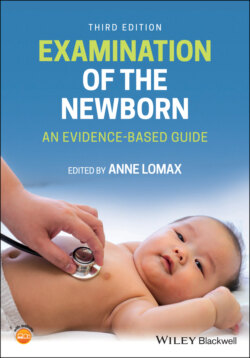Читать книгу Examination of the Newborn - Группа авторов - Страница 27
Previous obstetric and medical history
ОглавлениеThe medical history can reveal conditions such as maternal hypothyroidism, cardiac disease, type 1 or gestational diabetes, renal disease, epilepsy, blood disorders e.g. idiopathic thrombocytopenia, haemophilia or von Willebrand disease, or maternal depression. The surgical history may not have such a direct impact upon risk for the newborn but does add to the completeness of the history‐taking process for the NIPE practitioner.
TABLE 1.1 Key elements of the National Antenatal and Newborn Screening Programme.
Source: Adapted from the NHS Antenatal and Newborn Screening Programmes (PHE 2016, 2018a, 2020c).
| Screening tests | Timing | Biophysical details |
|---|---|---|
| Serology investigations | ||
| Blood profile to include group, rhesus and antibodies status and haemoglobin | At booking Antibodies and haemoglobin repeated at 28 weeks | Approximately 15% of the population are rhesus‐negative (Salem and Singer 2009). Anti‐D immunoglobulin is offered to all rhesus‐negative women at 28 weeks’ gestation to prevent haemolytic disease in the newborn. Maternal antibodies can also cause haemolytic disease. |
| Sickle cell | As early as possible, preferably by 10 weeks’ gestation | Inherited genetic condition resulting in the red blood cell forming a sickle cell shape. There are variants of this disease that impact on the severity. In cases where women are healthy carriers, the baby’s father should be offered screening. The risk of an affected infant is 1:2 where both parents are carriers (PHE 2018b). |
| Thalassaemia | As early as possible, preferably by 10 weeks’ gestation | Inherited genetic condition that affects the production of red blood cells. The genes that make haemoglobin are altered, causing anaemia. This condition takes two forms: alpha and beta (Ryan et al. 2010; PHE 2018b). |
| Hepatitis B | At booking | Some populations of women are at high risk of hepatitis B infection (HBsAG positive). Transmission of the virus is through sexual contact, vertical transmission or contaminated blood, e.g. needle sharing. Transmission to the fetus can be transplacental. Vaccination of the newborn must be offered to HBsAG positive women and their partners (PHE 2016, 2019b). |
| HIV | At booking | HIV infection is a retrovirus that causes an alteration of the immune system. The virus infects the CD4 cells or the helper T cells that lower the body’s cell‐mediated immunity. Infection with HIV‐1 can progress to AIDS (Carpenter et al. 2009; PHE 2016, 2019b). |
| Syphilis | At booking | Sexually transmitted disease with a risk of transplacental transmission (PHE 2016, 2019b) |
| First trimester combined test | 11+2 − 14+1 weeks | Combined screening test with combination of age, blood profile, nuchal scan measurement and other factors (PHE 2018b). |
| Ultrasonography | ||
| Nuchal translucency | 11+2 – 14+1 weeks (part of combined test) | Nuchal translucency measurement greater than 3.5 mm in early pregnancy. This finding is significant as associated with cardiac and syndromic pathology. This finding is also part of the ‘combined’ screening test for trisomy 21 (PHE 2018b). |
| Quadruple test | 14+2 − 20+0 weeks | Biochemistry tests, which include AFP, BHcG, oestriols and inhibin A (PHE 2018b). |
| Fetal anomaly | 18+0 − 20+6 weeks | This scan can detect certain gross structural anomalies but does have its limitations. Approximately 45% of cardiac defects can be detected at this time (PHE 2018b). |
| NIPE National Standards | Within first 72 hours of birth Repeated at 6–8 weeks of age | Full physical and behavioural examination of the newborn incorporating the four‐core condition‐related screening standards: developmental dysplasia of the hip, examination of the eye, congenital heart defects and undescended testes (PHE 2018a). |
Previous obstetric histories can provide information regarding maternal well‐being and pregnancy outcome that may be of relevance. The health of existing siblings should be noted. A previous intrauterine death, neonatal death or sudden infant death syndrome (SIDS) sibling should be noted. It is good practice to offer the option of an ECG being performed on the new sibling to rule out any risk of cardiac conduction disorders, e.g. prolonged QT syndrome or Wolff–Parkinson–White syndrome. The newborn would also be on the Care of Next Infant (CONI 2020) scheme with the provision of an apnoea monitor prior to discharge.
